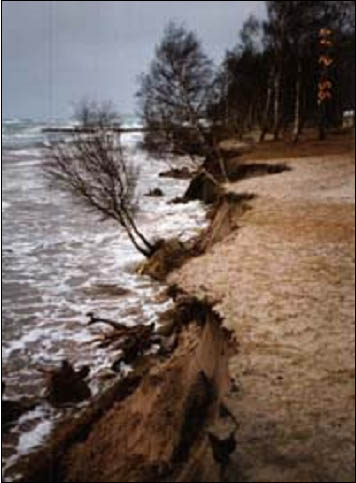| Ystad - Sweden |
| Complete description
of case study |
PHOTO OF THE SITE
 |
|
CASE STUDY
| Title | Ystad |
| National level | Sweden |
| Regional level | Skanelän county |
| Local level | Ystad |
ABSTRACT
|
Ystad is located at the southern tip of Sweden, in the province of Scania, east of Malmö. Sweden generally does not suffer from coastal erosion because of land uplift, but it does occur in Scania, where the land uplift is around zero and land subsidence – although it is really small and seems insignificant – will result in the long run in ongoing erosion on most Scania’s southern coast. The combination of high water levels with strong wind has on many occasions resulted in severe damage to the coast of Ystad municipality. West of Ystad, most of the beach consists of stone and gravel. On the coast at Ystad, some sea walls are present to protect the beach. East of Ystad, the beaches are mainly sandy with another sea wall. Over the years, these areas have been severely affected by erosion. The coastline has eroded by 1-1.5m/year, on average, for the last 150 years. The erosion mainly affects urban areas and industry and threatens human lives, property and investments. Recreational beaches are threatened. In general, the purposes of the protection works along the Ystad coast have been different for different areas. The effects have therefore also been different. Since 1950, the landowners
in this area have been dumping rocks and this temporary action saved the
buildings. However, in the long run, the (unprofessional) way in which
the dumping has occurred has resulted in much more severe damage and more
problems. However, the overall effect of the protection scheme at Ystad
has been positive. In some areas, the problem has been moved further downdrift
because only hard protective measures were applied. The aims can be the
protection of infrastructure, holding the line and rebuilding the sand
dunes. |
BASIC INFORMATION
| Coastal characteristics |
|
| Policy options | Hold
the line |
| Socio-economic activities | Agriculture and forestry, tourism and recreation, urbanisation, industry, nature conservation. |
| Engineering techniques | Groins, seawall, dune protection |
SOURCE
| Name | Hans Hanson |
| Institution | Dept. Of Water Resources Engineering, Lund University |
| Telephone / fax | +46 46 222-8987/ +46 46 222-4435 |